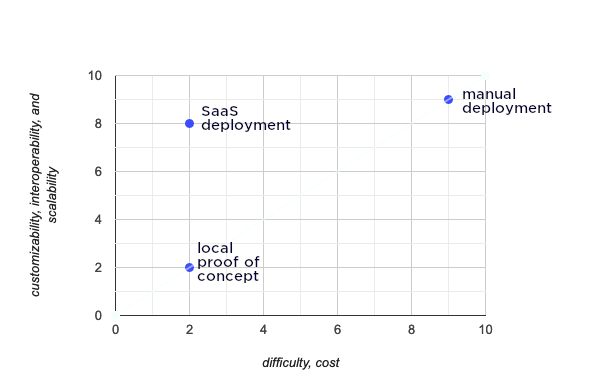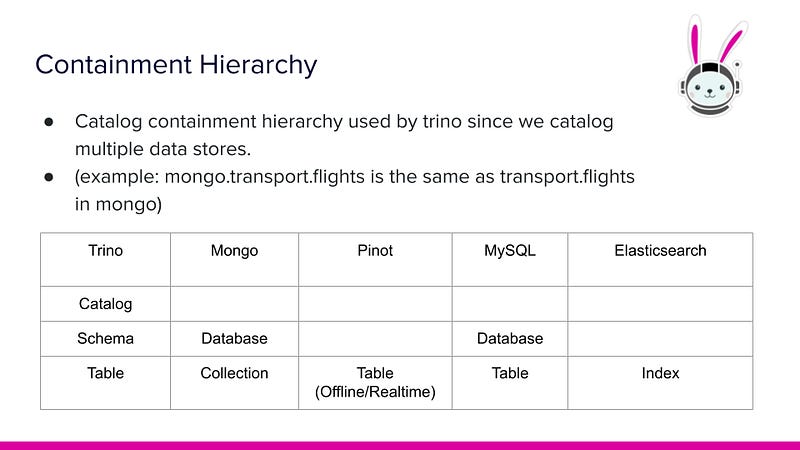Intro to Trino for the Trinewbie
Learn how to quickly join data across multiple sources
If you haven’t heard of Trino before, it is a query engine that speaks the language of many genres of databases. As such, Trino is commonly used to provide fast ad-hoc queries across heterogeneous data sources. Trino’s initial use case was built around replacing the Hive runtime engine to allow for faster querying of Big Data warehouses and data lakes. This may be the first time you have heard of Trino, but you’ve likely heard of the project from which it was “forklifted”, Presto. If you want to learn more about why the creators of Presto now work on Trino (formerly PrestoSQL) you can read the renaming blog that they produced earlier this year. Before you commit too much to this blog, I’d like to let you know why you should even care about Trino.
So what is Trino anyways?
The first thing I like to make sure people know about when discussing Trino is that it is a SQL query engine, but not a SQL database. What does that mean? Traditional databases typically consist of a query engine and a storage engine. Trino is just a query engine and does not store data. Instead, Trino interacts with various databases that store their own data in their own formats. Trino parses and analyzes the SQL query you pass in, creates and optimizes a query execution plan that includes the data sources, and then schedules worker nodes that are able to intelligently query the underlying databases they connect to.
I say intelligently, specifically talking about pushdown queries. That’s right, the most intelligent thing for Trino to do is to avoid making more work for itself, and try to offload that work to the underlying database. This makes sense as the underlying databases generally have special indexes and data that are stored in a specific format to optimize the read time. It would be silly of Trino to ignore all of that optimized reading capability and do a linear scan of all the data to run the query itself. The goal in most optimizations for Trino is to push down the query to the database and only get back the smallest amount of data needed to join with another dataset from another database, do some further Trino specific processing, or simply return as the correct result set for the query.
Query all the things
So I still have not really answered your question of why you should care about Trino. The short answer is, Trino acts as a single access point to query all the things. Yup. Oh, and it’s super fast at ad-hoc queries over various data sources including data lakes (e.g. Iceberg/Databricks) or data warehouses (e.g. Hive/Snowflake). It has a connector architecture that allows it to speak the language of a whole bunch of databases. If you have a special use case, you can write your own connector that abstracts any database or service away to just be another table in Trino’s domain. Pretty cool right? But that’s actually rarely needed because the most common databases already have a connector written for them. If not, more connectors are getting added by Trino’s open source community every few months.
To make the benefits of running federated queries a bit more tangible, I will present an example. Trino brings users the ability to map standardized ANSI SQL query to query databases that have a custom query DSL like Elasticsearch. With Trino it’s incredibly simple to set up an Elasticsearch catalog and start running SQL queries on it. If that doesn’t blow your mind, let me explain why that’s so powerful.
Imagine you have five different data stores, each with its own independent query language. Your data science or analyst team just wants access to these data stores. It would take a ridiculous amount of time for them to have to go to each data system individually, look up the different commands to pull data out of each one, and dump the data into one location and clean it up so that they can actually run meaningful queries. With Trino all they need to use is SQL to access them through Trino. Also, it doesn’t just stop at accessing the data, your data science team is also able to join data across tables of different databases like a search engine like Elasticsearch with an operational database like MySQL. Further, using Trino even enables joining data sources with themselves where joins are not supported, like in Elasticsearch and MongoDB. Did it happen yet? Is your mind blown?
Getting Started with Trino
So what is required to give Trino a test drive? Relative to many open-source database projects, Trino is one of the more simple projects to install, but this still doesn’t mean it is easy. An important element to a successful project is how it adapts to newer users and expands capability for growth and adoption. This really pushes the importance of making sure that there are multiple avenues of entry into using a product all of which have varying levels of difficulty, cost, customizability, interoperability, and scalability. As you increase in the level of customizability, interoperability, and scalability, you will generally see an increase in difficulty or cost and vice versa. Luckily, when you are starting out, you just really need to play with Trino.
Image added by Author
The low-cost and low difficulty way to try out Trino is to use Docker containers. The nice thing about these containers is that you don’t have to really know anything about the installation process of Trino to play around with Trino. While many enjoy poking around documentation and working with Trino to get it set up, it may not be for all. I certainly have my days where I prefer a nice chill CLI sesh and other days where I just need to opt-out. If you want to skip to the Easy Button way to deploy Trino (hint, it’s the SaaS deployment) then skip the next few sections.
Using Trino With Docker
Trino ships with a Docker image that does a lot of the setup necessary for Trino to run. Outside of simply running a docker container, there are a few things that need to happen for setup. First, in order to use a database like MySQL, we actually need to run a MySQL container as well using the official mysql image. There is a trino-getting-started repository that contains a lot of the setup needed for using Trino on your own computer or setting it up on a test server as a proof of concept. Clone this repository and follow the instructions in the README to install Docker if it is not already.
You can actually run a query before learning the specifics of how this compose file works. Before you run the query, you will need to run the mysql and trino-coordinator instances. To do this, navigate to the mysql/trino-mysql/ directory that contains the docker-compose.yml and run:
docker-compose up -d
Running your first query!
Now that you have Trino running in Docker, you need to open a session to access it. The easiest way to do this is via a console. Run the following Docker command to connect to a terminal on the coordinator:
docker container exec -it trino-mysql_trino-coordinator_1 trino
This will bring you to the Trino terminal.
trino>
Your first query will actually be to generate data from the tpch catalog and then query the data that was loaded into mysql catalog. In the terminal, run the following two queries:
CREATE TABLE mysql.tiny.customer
AS SELECT * FROM tpch.tiny.customer;
SELECT custkey, name, nationkey, phone
FROM mysql.tiny.customer LIMIT 5;
The output should look like this.
|custkey|name |nationkey|phone |
|-------|------------------|---------|---------------|
|751 |Customer#000000751|0 |10-658-550-2257|
|752 |Customer#000000752|8 |18-924-993-6038|
|753 |Customer#000000753|17 |27-817-126-3646|
|754 |Customer#000000754|0 |10-646-595-5871|
|755 |Customer#000000755|16 |26-395-247-2207|
Congrats! You just ran your first query on Trino. Did you feel the rush!? Okay well, technically we just copied data from a data generation connector and moved it into a MySQL database and queried that back out. It’s fine if this simple exercise didn’t send goosebumps flying down your spine but hopefully, you can extrapolate the possibilities when connecting to other datasets.
A good initial exercise to study the compose file and directories before jumping into the Trino installation documentation. Let’s see how this was possible by breaking down the docker-compose file that you just ran.
version: '3.7'
services:
trino-coordinator:
image: 'trinodb/trino:latest'
hostname: trino-coordinator
ports:
- '8080:8080'
volumes:
- ./etc:/etc/trino
networks:
- trino-network
mysql:
image: mysql:latest
hostname: mysql
environment:
MYSQL_ROOT_PASSWORD: admin
MYSQL_USER: admin
MYSQL_PASSWORD: admin
MYSQL_DATABASE: tiny
ports:
- '3306:3306'
networks:
- trino-network
networks:
trino-network:
driver: bridge
Notice that the hostname of mysql matches the instance name, and the mysql instance is on the trino-network that the trino-coordinator instance will also join. Also notice that the mysql image exposes port 3306 on the network.
Finally, we will use the trinodb/trino image for the trino-coordinator instance, and use the volumes option to map our local custom configurations for Trino to the /etc/trino directory we discuss further down in the Trino Configuration section. Trino should also be added to the trino-network and expose ports 8080 which is how external clients can access Trino. Below is an example of the docker-compose.yml file. The full configurations can be found in this getting started with Trino repository.
These instructions are a basic overview of the more complete installation instructions if you’re really going for it! If you’re not that interested in the installation, feel free to skip ahead to the Deploying Trino at Scale with Kubernetes section. If you’d rather not deal with Kubernetes I offer you another pass to the easy button section of this blog.
Trino requirements
The first requirement is that Trino must be run on a POSIX-compliant system such as Linux or Unix. There are some folks in the community that have gotten Trino to run on Windows for testing using runtime environments like cygwin but this is not supported officially. However, in our world of containerization, this is less of an issue and you will be able to at least test this on Docker no matter which operating system you use.
Trino is written in Java and so it requires the Java Runtime Environment (JRE). Trino requires a 64-bit version of Java 11, with a minimum required version of 11.0.7. Newer patch versions such as 11.0.8 or 11.0.9 are recommended. The launch scripts for Trino bin/launcher, also require python version 2.6.x, 2.7.x, or 3.x.
Trino Configuration
To configure Trino, you need to first know the Trino configuration directory. If you were installing Trino by hand, the default would be in a etc/ directory relative to the installation directory. For our example, I’m going to use the default installation directory of the Trino Docker image, which is set in the run-trino script as /etc/trino. We need to create four files underneath this base directory. I will describe what these files do and you can see an example in the docker image I have created below.
config.properties — This is the primary configuration for each node in the trino cluster. There are plenty of options that can be set here, but you’ll typically want to use the default settings when testing. The required configurations include indicating if the node is the coordinator, setting the http port that Trino communicates on, and the discovery node url so that Trino servers can find each other.
jvm.config — This configuration contains the command line arguments you will pass down to the java process that runs Trino.
log.properties — This configuration is helpful to indicate the log levels of various java classes in Trino. It can be left empty to use the default log level for all classes.
node.properties — This configuration is used to uniquely identify nodes in the cluster and specify locations of directories in the node.
The next directory you need to know about is the catalog/ directory, located in the root configuration directory. In the docker container, it will be in /etc/trino/catalog. This is the directory that will contain the catalog configurations that Trino will use to connect to the different data sources. For our example, we’ll configure two catalogs, the mysql catalog, and the tpch catalog. The tpch catalog is a simple data generation catalog that simply needs the conector.name property to be configured and is located in /etc/trino/catalog/tpch.properties.
tpch.properties
connector.name=tpch
The mysql catalog just needs the connector.name to specify which connector plugin to use, the connection-url property to point to the mysql instance, and the connection-user and connection-password properties for the mysql user.
mysql.properties
connector.name=mysql
connection-url=jdbc:mysql://mysql:3306
connection-user=root
connection-password=admin
Note: the name of the configuration file becomes the name of the catalog in Trino. If you are familiar with MySQL, you are likely to know that MySQL supports a two-tiered containment hierarchy, though you may have never known it was called that. This containment hierarchy refers to databases and tables. The first tier of the hierarchy is the tables, while the second tier consists of databases. A database contains multiple tables and therefore two tables can have the same name provided they live under a different database.
Image by Author
Since Trino has to connect to multiple databases, it supports a three-tiered containment hierarchy. Rather than call the second tier, databases, Trino refers to this tier as schemas. So a database in MySQL is equivalent to a schema in Trino. The third tier allows Trino to distinguish between multiple underlying data sources which are made of catalogs. Since the file provided to Trino is called mysql.properties it automatically names the catalog mysql without the .properties file type. To query the customer table in MySQL under the tiny you specify the following table name mysql.tiny.customer.
If you’ve reached this far, congratulations, you now know how to set up catalogs and query them through Trino! The benefits at this point should be clear, and making a proof of concept is easy to do this way. It’s time to put together that proof of concept for your team and your boss! What next though? How do you actually get this deployed in a reproducible and scalable manner? The next section covers a brief overview of faster ways to get Trino deployed at scale.
Deploying Trino at Scale with Kubernetes
Up to this point, this post only describes the deployment process. What about after that once you’ve deployed Trino to production and you slowly onboard engineering, BI/Analytics, and your data science teams. As many Trino users have experienced, the demand on your Trino cluster grows quickly as it becomes the single point of access to all of your data. This is where these small proof-of-concept size installations start to fall apart and you will need something more pliable to scale as your system starts to take on heavier workloads.
You will need to monitor your cluster and will likely need to stand up other services that run these monitoring tasks. This also applies to running other systems for security and authentication management. This list of complexity grows as you consider all of these systems need to scale and adapt around the growing Trino clusters. You may, for instance, consider deploying multiple clusters to handle different workloads, or possibly running tens or hundreds of Trino clusters to provide a self-service platform to provide isolated tenancy in your platform.
The solution to express all of these complex scenarios as the configuration is already solved by using an orchestration platform like Kubernetes, and its package manager project, Helm. Kubernetes offers a powerful way to express all the complex adaptable infrastructures based on your use cases.
In the interest of brevity, I will not include the full set of instructions on how to run a helm chart or cover the basics of running Trino on Kubernetes. Rather, I will refer you to an episode of Trino Community Broadcast that discusses Kubernetes, the community helm chart, and the basics of running Trino on Kubernetes. In the interest of transparency, the official Trino helm charts are still in an early phase of development. There is a very popular community-contributed helm chart that is adapted by many users to suit their needs and it is currently the best open source option for self-managed deployments of Trino. If you decide to take this route, proceed with caution and know that there is development to support the helm deployments moving forward.
While this will provide all the tools to enable a well-suited engineering department to run and maintain their own Trino cluster, this begs the question, based on your engineering team size, should you and your company be investing costly data engineer hours into maintaining, scaling, and hacking required to keep a full-size production infrastructure afloat?
Starburst Galaxy: The Easy Button method of deploying and maintaining Trino
Full Disclosure: This blog post was originally written while I was working at Starburst. I still stand by Starburst Galaxy as one of the better options but I will add the caveat that it depends on your use case and things change so reach out if you need my latest thoughts on the matter. That said, Galaxy is the general purpose version of Trino the creators never got to build at Facebook. If you have custom features you need that you'd like to contribute, a lot of folks run an open source cluster in testing and production is run by Starburst. You can then test and develop features to contribute to open source that will eventually upstream to Galaxy, Athena, or any other Trino variant.
Image By: lostvegas, License: CC BY-NC-ND 2.0
As mentioned, Trino has a relatively simple deployment setup, with an emphasis on relatively. This blog really only hits the tip of the iceberg when it comes to the complexity involved in managing and scaling Trino. While it is certainly possible to manage running Trino and even do so at scale with helm charts in Kubernetes, it is still a difficult setup for Trinewbies and difficult to maintain and scale for those who already have experience maintaining Trino. I experienced firsthand many of these difficulties myself when I began my Trino journey years ago and started on my own quest to help others overcome some of these challenges. This is what led me to cross paths with Starburst, the company behind the SaaS Trino platform Galaxy.
Galaxy makes Trino accessible to companies having difficulties scaling and customizing Trino to their needs. Unless you are in a company that houses a massive data platform and you have dedicated data and DevOps engineers to each system in your platform, many of these options won’t be feasible for you in the long run.
One thing to make clear is that a Galaxy cluster is really just a Trino cluster on demand. Outside of managing the scaling policies, to avoid any surprises on your cloud bill, you really don’t have to think about scaling Trino up or down, or suspending it when it is not in use. The beautiful thing about Trino and therefore Galaxy is that it is an ephemeral compute engine much like AWS Lambda that you can quickly spin up or down. Not only are you able to run ad-hoc and federated queries over disparate data sources, but now you can also run the infrastructure for those queries on-demand with almost no cost to your engineering team’s time.
Getting Started With Galaxy
Here’s a quick getting started guide with the Starburst Galaxy that mirrors the setup we realized with the Docker example above with Trino and MySQL.
- Set up a trial of Galaxy by filling in your information at the bottom of the Galaxy information page.
- Once you receive a link, you will see this sign-up screen. Fill out the email address, enter the pin sent to the email, and choose the domain for your cluster.
- The rest of the tutorial is provided in the video below provides a basic demo of what you’ll need to do to get started.
This introduction may feel a bit underwhelming but extrapolate being able to run federated queries across your relational databases like MySQL, a data lake storing data in S3, or soon data in many NoSQL and real-time data stores. The true power of Starburst Galaxy is that now your team will no longer need to dedicate a giant backlog of tickets aimed at scaling up and down, monitoring, and securing Trino. Rather you can return to focus on the business problems and the best model for the data in your domain.



